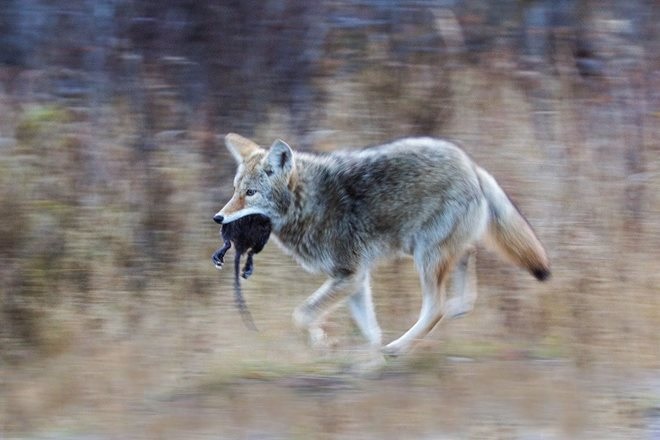
One warm fall afternoon I delivered a truckload of fertilizer to an Idaho wheat farmer. After unloading it, we sat in the back of his pickup resting and chatting when a coyote squeezed out of nearby brush and sauntered along the edge of a newly harvested wheat field.
“There goes my best employee. He works night and day nabbing the grasshoppers, rabbits and mice that gobble up my crops and profit and never asks for a paycheck,” the farmer said. As we watched, the coyote dove into the grass and emerged with a mouse in his mouth.
I’d shot my first rooster pheasant on a neighboring farm a couple of falls previously. That was nearly a half century ago when the Palouse crawled with both ringnecks and coyotes. Years later, while pheasant hunting in Iowa, a coyote crossed my path 30 yards out. I was tempted to salute it with the load of 4’s in my double’s left barrel, but remembered the Palouse farmer’s comments. Instead, I reached into my vest for a camera, but before I could snap a photo, the coyote winded me and vacated with speedy enthusiasm.
It’s logical for hunters to assume shooting coyotes boosts pheasant numbers. Everyone knows that coyotes are predators and pheasants are both tasty and meaty. But does it really help pheasant numbers to hurl a load of shot at one?
Predation is complex. Biologist and pheasant hunters are beginning to realize that what seems common sense may not be confirmed by research. It seems counter intuitive, but a healthy coyote population probably favors increased numbers of pheasants because they either drive off or kill the smaller animals that are more serious pheasant and nest predators

“Coyotes are not major predators of pheasants or their nests or chicks,” said Todd Bogenschutz, small game biologist for the Iowa DNR. He and wetland and furbearer biologist, Vince Evelsizer, agree that coyotes’ dining preference is small mammals. “Coyotes do not like having raccoons, foxes, opossums, mink and weasels around, and these are serious pheasant nest predators,” said Bogenschutz.
Coyotes are opportunistic eaters that are always hungry and rarely picky. According to the Washington Department of Fish and Wildlife, their diet includes mice, rats, gophers, mountain beavers, rabbits, squirrels, snakes, lizards, frogs, fish, birds and plenty of grasshoppers and other insects. Come warm weather, they round out their diet with grass and fruit. Near farms and in town they enjoy pet food, garbage, garden crops, poultry and pets, especially cats. With all those choices, they have little need to hunt relatively hard-to-catch pheasants.
Dave Ohlen and several friends have owned a large central South Dakota farm for decades and manage it for pheasants. “Years ago, we would have shot coyotes, but I don’t think any of us would now. We know that raccoons, skunks and feral cats are our biggest pheasant predators. I’ve actually seen a cat carrying a rooster,” he said.
Wild members of the dog family simply do not like having their smaller cousins around. Washington State’s data show that coyotes kill domestic dogs and foxes, probably because they consider them territorial intruders. There’s little doubt that when coyote densities are high fox numbers decline. These smaller predators are more effective pheasant predators than their larger cousins. Dogs aren’t immune to coyote hostility. Several years back one killed and ate several small dogs in and around Cedar Rapids, Iowa neighborhoods, to the consternation of their owners.
There is little specific research to determine the precise impact of coyote density on pheasant numbers. Most research centers on the general food preferences of coyotes or predation on other bird species. An extensive study in the Dakotas on duck nesting success showed that coyotes depressed nest predator populations and helped increase waterfowl numbers. The same probably holds true for pheasants.
In my youthful hunting years, I would have never passed up a chance to ‘help’ pheasants by shooting any coyote that came into range. No longer. Instead of sending a pheasant load his way I merely shout, “Thanks fella!”
By Rich Patterson,
